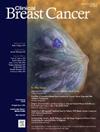乳腺癌新辅助化疗后腋窝病理完全缓解患者与初始淋巴结阴性患者10年生存率的比较。
IF 2.9
3区 医学
Q2 ONCOLOGY
引用次数: 0
摘要
目的:我们旨在确定细胞学证实的淋巴结阳性疾病患者在新辅助化疗(NAC)后达到腋窝病理完全缓解(ypN0)是否与最初病理阴性淋巴结(pN0)的患者具有相似的生存结果。方法:回顾性分析2005年6月至2012年3月间某大型肿瘤医院经细胞学证实的淋巴结阳性乳腺癌NAC术后pN0及pN0的患者。计算比较两组患者的无复发生存期(RFS)、远端无病生存期(DDFS)和总生存期(OS)。结果:本研究共纳入2285例患者,其中ypN0患者183例,pN0患者2102例。患者的中位随访时间为121个月(2-182个月)。ypN0患者的10年累积RFS为79.7%,pN0患者为90.2% (log-rank P < 0.001)。ypN0患者10年累积DDFS为81.4%,pN0患者为92.2% (log-rank P < .001)。ypN0患者10年累积OS为86.3%,pN0患者为94.0% (log-rank P < 0.001)。多变量Cox比例风险模型显示,与pN0患者相比,ypN0患者的复发风险增加2.00倍(HR = 2.00, 95% CI, 1.33 ~ 3.01, P = 0.001),远处复发风险增加2.34倍(HR = 2.34, 95% CI, 1.52 ~ 3.62, P < 0.001),死亡风险增加2.10倍(HR = 2.10, 95% CI, 1.25 ~ 3.53, P = 0.005)。结论:腋窝pCR患者的RFS、DDFS和OS均低于pN0患者。本文章由计算机程序翻译,如有差异,请以英文原文为准。
Comparison of 10-Year Survival Between Patients With Axillary Pathologic Complete Response After Neoadjuvant Chemotherapy and Patients With Initially Negative Nodes in Breast Cancer
Purpose
We aimed to determine whether patients with cytologically proven node-positive disease who achieved axillary pathologic complete response (ypN0) after neoadjuvant chemotherapy (NAC) have similar survival outcomes to those with initially pathologically negative lymph nodes (pN0).
Methods
Patients with cytologically proven node-positive breast cancer who achieved ypN0 after NAC and those with pN0 between June 2005 and March 2012 in a large cancer hospital were reviewed. The relapse-free survival (RFS), distant-disease-free survival (DDFS) and overall survival (OS) of the 2 groups were calculated and compared.
Results
A total of 2285 patients, including 183 patients with ypN0 and 2102 patients with pN0, were included in this study. The median follow-up time for patients was 121 (range 2-182) months. The 10-year cumulative RFS was 79.7% for ypN0 patients and 90.2% for pN0 patients (log-rank P < .001). The 10-year cumulative DDFS was 81.4% for ypN0 patients and 92.2% for pN0 patients (log-rank P < .001). The 10-year cumulative OS was 86.3% for ypN0 patients and 94.0% for pN0 patients (log-rank P < .001). The multivariable Cox proportional hazards models showed that compared with pN0 patients, ypN0 patients had a 2.00-fold increase in the risk of recurrence (HR = 2.00, 95% CI, 1.33-3.01, P = .001), a 2.34-fold increase in the risk of distant recurrence (HR = 2.34, 95% CI, 1.52-3.62, P < .001) and a 2.10-fold increase in the risk of death (HR = 2.10, 95% CI, 1.25-3.53, P = .005).
Conclusion
Patients with axillary pCR showed inferior RFS, DDFS and OS to patients with pN0.
求助全文
通过发布文献求助,成功后即可免费获取论文全文。
去求助
来源期刊

Clinical breast cancer
医学-肿瘤学
CiteScore
5.40
自引率
3.20%
发文量
174
审稿时长
48 days
期刊介绍:
Clinical Breast Cancer is a peer-reviewed bimonthly journal that publishes original articles describing various aspects of clinical and translational research of breast cancer. Clinical Breast Cancer is devoted to articles on detection, diagnosis, prevention, and treatment of breast cancer. The main emphasis is on recent scientific developments in all areas related to breast cancer. Specific areas of interest include clinical research reports from various therapeutic modalities, cancer genetics, drug sensitivity and resistance, novel imaging, tumor genomics, biomarkers, and chemoprevention strategies.
 求助内容:
求助内容: 应助结果提醒方式:
应助结果提醒方式:


